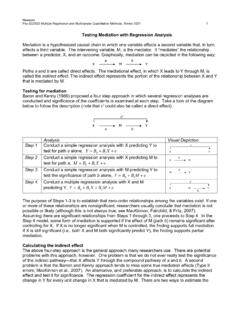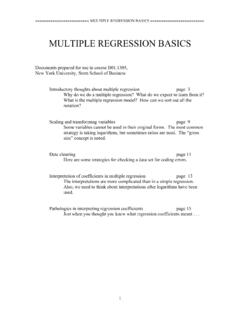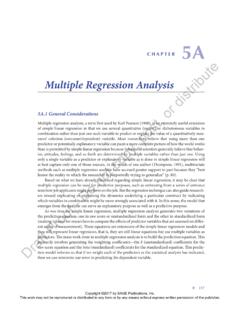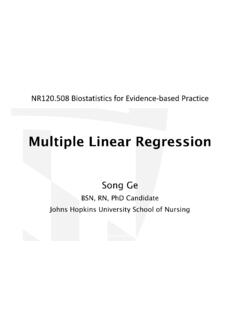Transcription of Lesson 21: Multiple Linear Regression Analysis
1 Lesson 21: Multiple Linear Regression Analysis Motivation and Objective: We've spent a lot of time discussing simple Linear Regression , but simple Linear Regression is, well, simple in the sense that there is usually more than one variable that helps explain the variation in the response variable. Multiple Linear Regression (MLR) is an Analysis procedure to use with more than one explanatory variable. Many of the steps in performing a Multiple Linear Regression Analysis are the same as a Simple Linear Regression Analysis , but there are some differences. In this Lesson , we'll start by assuming all conditions of the Multiple Linear Regression model are met (we'll talk more about these conditions in Lesson 22) and learn how to interpret the output.
2 By the end of this Lesson , you should understand 1) what Multiple Regression is, and 2) how to use and interpret the output from a Multiple Regression Analysis . What is Multiple Linear Regression ? Multiple Linear Regression is an Analysis procedure to use when more than one explanatory variable is included in a model . That is, when we believe there is more than one explanatory variable that might help explain or predict the response variable, we'll put all of these explanatory variables into the model and perform a Multiple Linear Regression Analysis . Multiple Linear Regression Model The Multiple Linear Regression model is just an extension of the simple Linear Regression model.
3 In simple Linear Regression , we used an x to represent the explanatory variable. In Multiple Linear Regression , we'll have more than one explanatory variable, so we'll have more than one x in the equation. We'll distinguish between the explanatory variables by putting subscripts next to the x's in the equation. Multiple Linear Regression Model: y = 0 + 1x1 + 2 x 2 + .. + v x v + . where y = an observed value of the response variable for a particular observation in the population 0 = the constant term (equivalent to the y-intercept in SLR). j = the coefficient for the jth explanatory variable (j = 1, 2, , v).
4 X j = a value of the jth explanatory variable for a particular observation (j = 1, 2, , v). = the residual for the particular observation in the population In Simple Linear Regression , it was easy to picture the model two-dimensionally with a scatterplot because there was only one explanatory variable. If we had two explanatory variables, we could still picture the model: the x-axis would represent the first explanatory variable, the y-axis the second explanatory variable, and the z-axis would represent the response variable. The model would actually be an equation of a plane.
5 However, when there are three or more explanatory variables, it becomes impossible to picture the model. That is, we can't visualize what the equation represents. Because of this, 0 is not called a y-intercept . anymore but is just called a constant term. It is the value in the equation without any x next to it. (It is often called a constant term in simple Linear Regression as well, but we can visualize what this constant term is in simple Linear Regression it's the y-intercept!). Question: If all the explanatory variables had a value of 0 and the residual of an observation is 0, what is the value of the response variable?
6 Answer: Likewise, the numbers in front of the x's are no longer slopes in Multiple Regression since the equation is not an equation of a line anymore. We'll call these numbers coefficients, which means numbers in front of . As we will see, the interpretation of the coefficients ( 1, 2 , etc. ) will be very similar to the interpretation of the slope in simple Linear Regression . As with Simple Linear Regression , there are certain conditions that must exist in Multiple Linear Regression for conclusions from the Analysis to be valid to a particular population of interest.
7 Many of these conditions will be the same or similar as in Simple Linear Regression . We will talk about these conditions and checks of these conditions in Lesson 22. Even though it is important to make sure all of the conditions are met before doing an Analysis , we'll concentrate only on the Analysis in this Lesson under the assumption that all conditions are met. (Note: this is backwards and is the ONLY time we'll ever do an Analysis without checking the conditions first, but it might be more interesting for all of us to see what the Analysis is all about first.)
8 Performing the Multiple Linear Regression Analysis The following ActivStats tutorials discuss how to read the Minitab output from a Multiple Linear Regression Analysis . We'll go through another example in detail explaining and expanding on certain aspects of the output. It is recommended to view the tutorials now and again after the completion of the example to follow. : Go to page 26-1 in the Lesson Book : Watch the Nambe Hills Story on Metalware Pieces : Learn to Read the Multiple Regression Table in MINITAB. (Note: you will learn HOW to use Minitab to do a MLR Analysis in a Lab Activity).
9 : Learn More About the Multiple Regression Table in MINITAB. : Go to page 26-3 in the Lesson Book : Understand How the Values in the Table are Interrelated Example : The Literacy Rate Example Literacy rate is a reflection of the educational facilities and quality of education available in a country, and mass communication plays a large part in the educational process. In an effort to relate the literacy rate of a country to various mass communication outlets, a demographer has proposed to relate literacy rate to the following variables: number of daily newspaper copies (per 1000 population), number of radios (per 1000 population), and number of TV sets (per 1000 population).
10 Here are the data for a sample of 10 countries: Country newspapers radios tv sets literacy rate Czech Republic /. Slovakia 280 266 228 Italy 142 230 201 Kenya 10 114 2 Norway 391 313 227 Panama 86 329 82 Philippines 17 42 11 Tunisia 21 49 16 USA 314 1695 472 Russia 333 430 185 Venezuela 91 182 89 Question: What is the response variable? What are the explanatory variables? Answer: Below is the Minitab output from a Multiple Linear Regression Analysis . Predictor Coef SE Coef T P. Constant newspaper copies radios television sets S = R-Sq = R-Sq(adj) = Analysis of Variance Source DF SS MS F P.








